Thus, we come to the end of my article series on the decks of Commander 2013. I started by giving the spoiled generals a look back in October, and then spent two weeks on the new and notable cards included in the decks. I made some mistakes in my initial evaluations for sure; I didn’t have sufficient respect for Derevi, Empyrial Tactician’s power, I overestimated how dickish Price of Knowledge was going to be in play, and I misread the order of effects on Widespread Panic, making it a less powerful card than I had thought. But these are minor things! My initial evaluation mostly did see the heart of the cards.
Of course, you can only tell so much from a spoiler. That’s why I continued my series with an article on how the different decks played out of the box. For the most part, the decks weren’t amazing to play as is; the skeleton of manabase and removal options seemed pretty solid across the five decks, but each one was split between at least two different themes. Jeleva, Nephalia’s Scourge was trying to be all spells and also a Nekusar, the Mindrazer griefer deck, Derevi was half Roon of the Hidden Realm’s mulldrifters and half activated-ability-style baneslayers, Oloro, Ageless Ascetic was split between lifegain and artifacts matter (a la Sydri, Galvanic Genius and Sharuum the Hegemon), Marath, Will of the Wild wanted to be token-based but also follow Mayael the Anima’s size matters theme, and Prossh, Skyraider of Kher was split between token-swarm and the Shattergang Brothers‘ sacrificial control. So, each deck had the spark of greatness, but on the whole they were a little buggy straight from the packaging.
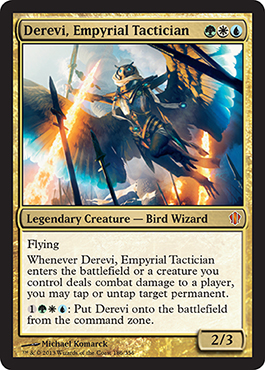
That’s why I spent the next six weeks massaging those sparks into some blazingly powerful 99s. I started with Derevi, making a deck that not only turned the large number of untap triggers into card advantage, but also managed to make disgustingly large quantities of mana through sol lands and a subtheme of elven manadorks. Later, I went back and dialed a bit back on the colorless mana theme, since I just didn’t have enough to do with them, but I liked the “untap during your opponents’ turns” part of the deck enough to procure some copies of Seedborn Muse and Awakening to truly turbocharge this part of the deck. I’ll admit, it makes me feel a little dirty to be playing those cards, but Prophet of Kruphix is everywhere these days and if you can’t beat them, join them! I played this one match with Derevi, who turned out to be one of the more entertaining decks when all was said and done, that revolved around a Geth, Lord of the Vault deck constantly reanimating my Prophet of Kruphix before it would get passed around the table. That card is bonkers, and it’s on everyone’s radar.
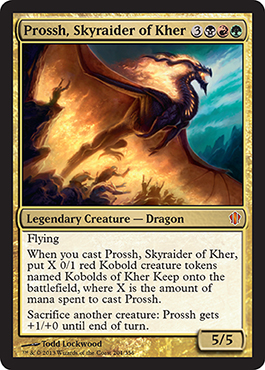
From there I moved on to Prossh. I was initially surprised by the raw power offered by Prossh, but I probably shouldn’t have been. That card is bonkers, and it goes infinite with a lot of cards. The most obvious is still Food Chain, but I couldn’t bring myself to actually slot it in there, since I didn’t really have any plans to take advantage of infinite enters-the-battlefield triggers. Instead, I just focused on the basics, figuring that Prossh’s legion of weak tokens would be more effective when they had more reasonable force multipliers bumping their power. I finally found a deck that enjoyed playing Gaea’s Anthem, and Curse of Predation turned into a shocking all-star. Since writing the article, the holidays brought me copies of Doubling Season and Greater Good, both of which were added to give the deck a further edge… not that it needed it. Realistically, Prossh seemed the deck that needed the fewest substitutions to bring it up to a viable power level. If you want to buy one of these decks for the sole purpose of making yourself the type of deck that can throw down with the best of them, this is the one. Just… mind the tuck.
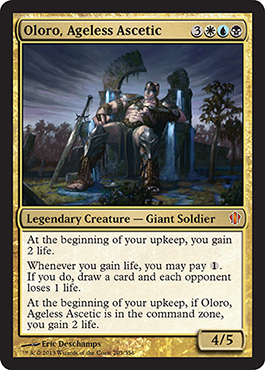
So I continued the series with my take on Oloro. Oloro, Ageless Ascetic as a general, has a drawback that isn’t immediately apparent until you take him out for a jaunt: keeping track of a constant stream of lifegain is a pain in the butt. The deck itself is fine, and the general is amazing, but keeping track of it is less than pleasant… and that’s before I went the Soul Sisters route. My favorite part of the deck isn’t even on theme, but was instead my value-Zur the Enchanter package. Esper has a lot of valuable control enchantments at CMC three or less, and whether I draw them or untap with Zur to go find them, they’re generally pretty good bang for the buck. When going on my holiday singles expedition, I stumbled upon the perfect card for this deck: Cleansing Meditation. It’s Tranquility, but with upside, and in a deck that plays a lot of enchantments with ETB triggers, it seemed quite promising. The best part is that it has the potential to even rez Rune-tail, Kitsune Ascendant, which is good because that’s not an enchantment when it’s in your hand or graveyard. All in all Oloro never really made it to the top tier, despite a brutal commander ability, but the deck also didn’t require much in the way of modifications from its initial formation. Maybe Soul Sisters isn’t the best direction to take this deck, but short of ripping out that theme the deck’s in a pretty solid place.
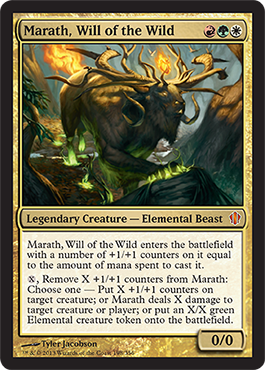
The penultimate deck was Marath, Will of the Wild, and I initially found myself rather stumped by the challenge. Perhaps it is my Ghave, Guru of Spores deck that interfered with seeing the most obvious direction to pull the deck, or maybe it was the similarity between what Marath does best and the way that I built Prossh. Either way, I skipped over the token-swarm theme in favor of building a deck themed around monstrous +1/+1 counters. Initially this idea fell rather flat, as one can imagine. Since the article, though, I’ve worked on the deck some more, and I ended up in a rather solid place with it. Instead of going all in on the counter theme, I realized the nature of Marath makes her the perfect mana sink, and thus went all in on the exponential doubling of mana. From there, I also added in some other doublers, like Doubling Season, and my current build of Marath is basically a mathcore deck, but slightly less of an auditory assault. I finally caved in and added Primeval Bounty to the deck, and it’s a good reflection of the deck as a whole now: powerful, but boring. That the You Make the Card contest ended up with a version of Primeval Bounty is the worst thing to happen to MTG this year, and I am including the downtime on MTGO. People have no imagination anymore. Still, it’s a powerful effect, and I can’t wait to resolve Primeval Bounty on a board that already included a Primal Vigor or Doubling Season.
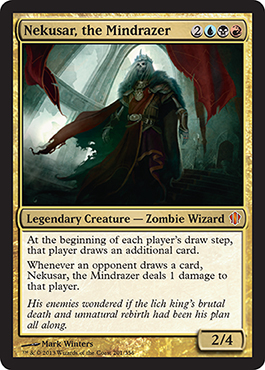
Finally, I ended my run with Nekusar. I’ve basically given this deck to my partner, Dana, but that doesn’t mean I haven’t taken it for a few spins. It’s surprisingly fun for a griefer deck, and it allows me to play with the most entertaining junk card ever: Seer’s Vision. Since the entire goal in playing Nekusar is to keep everyone off balance and sated with draw to ignore the slow cinch of enveloping death, Seer’s Vision is a shockingly effective roleplayer. When everyone else is a) drawing a ton of cards, and b) showing the cards they’re drawing to the rest of the table, it becomes a lot easier to point out the danger that other people on the board are posing in a more immediate fashion than Nekusar ever could. I mean, Nekusar is not the type of general to kill your opponent with general damage (although throw Elder Mastery on him and he easily could). Nekusar is never going to offer the same threat profile as Sigarda, Host of Herons, for example. And so long as one can talk fast and toe the cost-benefit line, Nekusar’s the type of griefer deck to run slightly under the radar until it’s too late.
Which brings us to the here and now. Article ten of ten, the last time I’ll be looking at Commander 2013 in such an ordered fashion. The review. And my review for this set is an A-. It’s basically a great product, but it’s missing a few things and the decks could have been a bit stronger from the start. The inclusion of Legacy’s new mini-Progenitus in the Grixis deck has left that deck basically impossible to find, and certainly not at MSRP. Meanwhile, some of the other ones with lower EVs finally made it into the stores after the demand for the decks plummeted, and as a result you can find things like four copies each of Derevi and Marath in the rural Target near my familial home in PA. Which is going to be unfortunate for the novice player who wants to get into the format through those decks, since neither one of them is the strongest entry point (although Derevi at least gives some decent trade fodder in Unexpectedly Absent). So I am a little unsure as to what the lasting legacy of this set will be. Hopefully, at the least, it means biennial releases of new Commander products. I wouldn’t mind seeing that bumped up to yearly releases, since it seems like Commander is the best format for casual players, but I do love me some Planechase so I guess it evens out. I do not, however, expect to see more Archenemy. I think I’ve played all of four games of that format since it came out; calibrating the power balance on those things is always difficult.
Anyway, I’d like to end by highlighting some inclusions I brought into these decks that could easily pass by unnoticed. A few of them are just unassuming cards that should see more play in EDH; one or two have the three-color restriction that makes it so hard to find them a home.
That’s the case for Meglonoth, the card I would like to highlight from Marath. Meglonoth used to be my pet stompy card, back when I was returning to the game after a hiatus. I love it because it wears armor like a champ, and makes for a fairly stunning rattler. It’s not the best card, and the shard color identity means I don’t get to play with it all too often, but I’m a fan, and I am glad Commander 2013 gave me a chance to play with it again.
For Derevi, my underrated card is Gilder Bairn. If you’re unclear as to the nature of the ability that Gilder Bairn is showing off, that’s because the untap symbol only really made its mark on a single block. They should bring back untap abilities! Anyway, Derevi, Empyrial Tactician can tap as well as untap, and Gilder Bairn can target planeswalkers as well as creatures with +1/+1 counters on them. As is, the deck doesn’t take too much advantage of this, other than a single copy of Venser, the Sojourner, but I’m a fan either way.
My favorite underrated card for Prossh is Hit and Run (and yes, I would link it but I have yet to find a magic plug-in that handles split cards well). In the deck, Hit and Run performs amazingly. The edict effect of Hit has come in handy both as a way to sacrifice a card in a pinch (like a tuck effect aimed at Prossh) and as pure removal. And Run, with Prossh, Skyraider of Kher, is disgusting. A Run based only on an initial casting of Prossh and the six tokens he brings represents over 40 damage. That’s lethal. And the longer you hold off on casting it, the more disgusting of a swing it represents. Add in Nylea, God of the Hunt and the Bow of Nylea, and suddenly that damage seems almost certain to get through. And that’s not even to speak of the fact that, as an instant, you can play it after your opponent mistakenly let through your army of Kobolds of Kher Keep; no one plays around uncommon split cards from the Dissention era.
For Nekusar, the underrated card was pretty obvious: Kagemaro, First to Suffer. Generally, the Maro cycle from Kamigawa block is shit. The green and red ones are just big, vanilla dudes, and the white and blue ones are fairly unassuming as well, if less vanilla. Kagemaro, though, fits perfectly into Nekusar’s theme. Usually, Kagemaro is going to have plenty of cards to grow fat upon, what with the “draw a bunch of cards” theme of the deck, but it not only serves as an effective attacker and blocker, but it comes tied to its own Mutilate-style wrath. It’s a steal at five mana, and I wanted to make sure that I gave it a shout out during this final review.
And, finally, the final card from the final general in my final review: Pontiff of Blight, representing Oloro. The only way you could have improved Oloro, Ageless Ascetic, is to give the card extort. And Pontiff of Blight does this. With Oloro, Ageless Ascetic on the board, each creature you control gives you multikicker “1(w/b) – draw a card, each opponent loses 2 life, you gain 1 life for each other player.” That’s pretty damn cool, and unlike actual multikicker cards you don’t have to choose to pay until after you’ve drawn your card. This way, if you have three or four triggers on the stack, you can draw down until you get your out, and still have the chance to cast it. It’s such a sweet interaction with Oloro, Ageless Ascetic, and this bulk rare particularly shines in the context.
So, that’s all folks! It’s been a fun run, even if I am getting a little tired of analyzing these five decks. Next week I’ll be returning to a classic, specifically Ghave, Guru of Spores from the initial Commander product, and have I got a story for you! It hinges on cats. Exponential cats. See you then!

